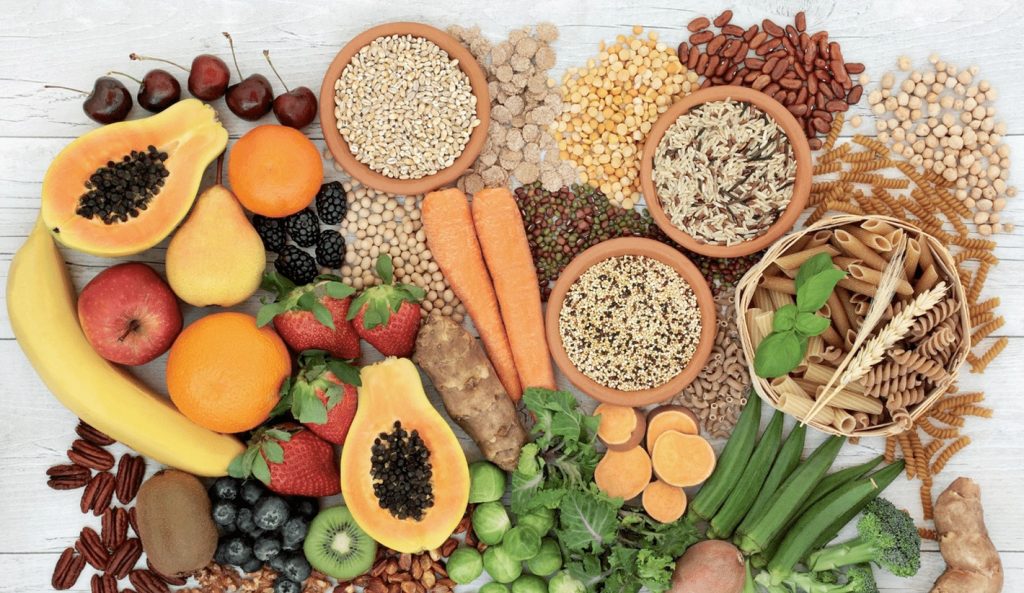
With industrialization came a decline in fiber use as it was viewed as undesirable so grains were milled to remove most dietary fiber[1]. The reduction in fiber began a cascade of unwanted health issues that still contribute to chronic disease today.
In 2005 the lack of fiber in Americans’ diet was identified as a Public Health Concern and it remains a concern today. The Institute of Medicine points out that currently over ninety percent of all Americans’ intake of fiber is well below the daily recommended level. The IOM Recommend 25-38 grams of fiber per day, the average American consumes about 12 grams of fiber per day.
Basically, dietary fiber is the cell wall of plants, and these carbohydrates cannot be broken down by an acid environment or digested directly by humans. The follow are the two main types of fiber[2].
Soluble fiber include gums, pectins, mucilages and some hemicelluloses. This fiber dissolves in water to make a gel-like material. Great sources would be apples, barley, beans, bran, citrus fruits oats, peas, potatoes, psyllium and strawberries. Soluble fiber absorbs fluid which increases the stool weight. Soluble fibers are fermented in the colon by our healthy microbiome
Insoluble Fiber increase stool bulk. It includes cellulose, hemicellulose, modified cellulose and lignins. Great sources of insoluble fiber include flaxseed, root vegetables, wheat bran, grains, legumes, and vegetables
Health Benefits
- Fiber is the main source of fuel for the microbiome and it allows it to stay diverse and healthy. Most soluble fiber is fermented by the bacteria in the colon, our microbiome, to produce short-chain fatty acids (SCFA) which, in turn, are used as energy both for the bacteria and human cells. The bacteria in the colon modulate our weight[3], mood[4],[5] and overall health[2]. To date the exact mechanisms have not been elucidated.
- Fiber promotes lower weight through feeling of satiety and delays absorption of simple sugars which lowers the glycemic level. Also SCFA enhance the guts satiety hormone PYY to be released to the brain[6].
- Fiber reduces cardiovascular disease. The fiber binds with bile acids and cholesterol and excretes them in feces. Also the SCFA produced in the microbiome reduce blood pressure[1],[2],[7].
- The gut microbime as mentioned above ferments fiber to produce SCFA one being butyrate. Butyrate is able to signal a pathway for colon cancer cell apoptosis (death of cell) reducing the risk of colon cancer[8],[9]. A high fiber diet may decrease the occurrence of diverticulitis[10].
- Fiber keeps bowels regular. Fiber alters the bulk and composition and speeds up the transit time of feces. Close to 16% of Americans suffer with constipation and a high fiber diet is a standard recommendation from most medical professionals to alleviate this problem[11].
- Fiber aids in the development of infants. Human Milk Oligosaccharides are produced during lactation and the baby receives around 25 grams of fiber a day in breast milk[12].
- Fiber consumption alters the gut microbiome, which can modulate uremic toxin generation from protein rich diets and slow CKD progression, along with reducing cardiovascular risk in CKD patients[1].
Foods High in Fiber
If you are low on daily intake, increase your whole food fiber 2-3 grams every 3-4 days.
- Beans 15 grams per cup
- Artichokes 10 grams per medium size
- Avocados 10 grams per medium size
- Raspberries 8 grams per cup
- Broccoli 5 grams per cup
- Apples 3.3 grams per medium size
Supplemental Fiber
It’s best to get fiber from food such as whole grains, fruits and vegetables[2]. Drink a lot of water when taking any of these products, as they can clog up your intestines. Do not take your mineral supplements with a high fiber meal as the fiber will bind with the mineral and lower the absorption rate.
If you do decide to supplement it is best to ask your physician first.
References
[1] Kalantar-Zadeh, Kamyar, et al. “Plant-Dominant Low-Protein Diet for Conservative Management of Chronic Kidney Disease.” (2020
[2] Anderson, James W., et al. “Health benefits of dietary fiber.” Nutrition reviews 67.4 (2009): 188-205.
[3] Howarth, Nancy C., Edward Saltzman, and Susan B. Roberts. “Dietary fiber and weight regulation.” Nutrition reviews 59.5 (2001): 129-139.
[4] Bourassa, Megan W., et al. “Butyrate, neuroepigenetics and the gut microbiome: can a high fiber diet improve brain health?.” Neuroscience letters 625 (2016): 56-63.
[5] Dinan, Timothy G., and John F. Cryan. “Mood by microbe: towards clinical translation.” Genome medicine 8.1 (2016): 36.
[6] Silva, Ygor Parladore, Andressa Bernardi, and Rudimar Luiz Frozza. “The role of short-chain fatty acids from gut microbiota in gut-brain communication.” Frontiers in Endocrinology 11 (2020): 25.
[7] Musilova S, Rada V, Vlkova E, Bunesova V. Beneficial effects of human milk oligosaccharides on gut microbiota. Benef Microbes. 2014;5(3):273‐283. doi:10.3920/BM2013.0080
[8] Baxter BA, Oppel RC, Ryan EP. Navy Beans Impact the Stool Metabolome and Metabolic Pathways for Colon Health in Cancer Survivors. Nutrients. 2018;11(1):28. Published 2018 Dec 22. doi:10.3390/nu11010028
[9] Chen, Jiezhong, and Luis Vitetta. “Inflammation-modulating effect of butyrate in the prevention of colon cancer by dietary fiber.” Clinical colorectal cancer 17.3 (2018): e541-e544.
[10] Strate, Lisa L., and Arden M. Morris. “Epidemiology, pathophysiology, and treatment of diverticulitis.” Gastroenterology 156.5 (2019): 1282-1298
[11] Bharucha, A. E., G. R. Locke, and J. H. Pemberton. “AGA practice guideline on constipation: technical review.” Gastroenterology 144.1 (2013): 218-238.
[12] Mahmood, Mahmood W., et al. “High intake of dietary fibre from fruit and vegetables reduces the risk of hospitalisation for diverticular disease.” European journal of nutrition 58.6 (2019): 2393-2400.